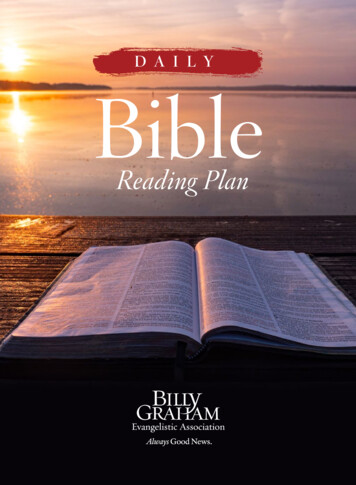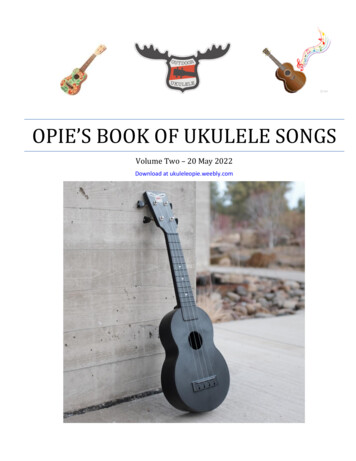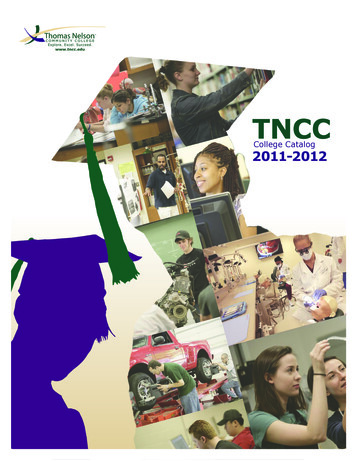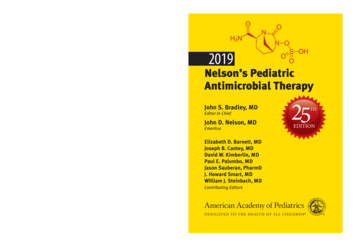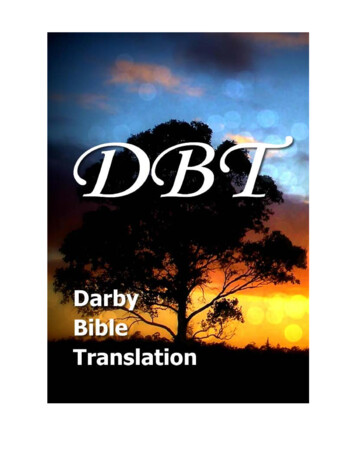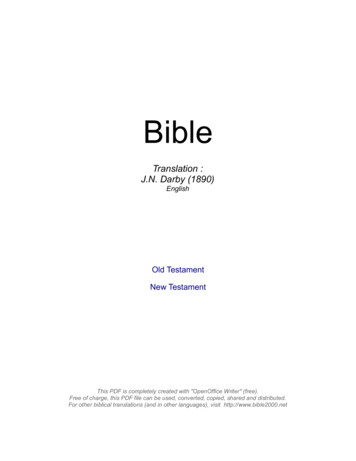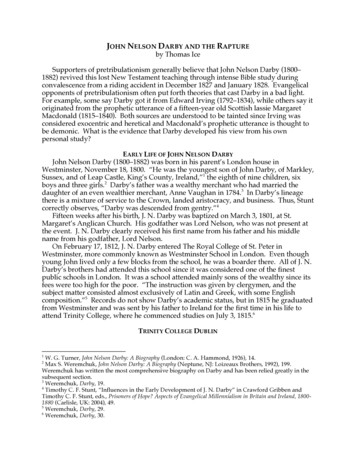
Transcription
JOHN NELSON DARBY AND THE RAPTUREby Thomas IceSupporters of pretribulationism generally believe that John Nelson Darby (1800–1882) revived this lost New Testament teaching through intense Bible study duringconvalescence from a riding accident in December 1827 and January 1828. Evangelicalopponents of pretribulationism often put forth theories that cast Darby in a bad light.For example, some say Darby got it from Edward Irving (1792–1834), while others say itoriginated from the prophetic utterance of a fifteen-year old Scottish lassie MargaretMacdonald (1815–1840). Both sources are understood to be tainted since Irving wasconsidered exocentric and heretical and Macdonald’s prophetic utterance is thought tobe demonic. What is the evidence that Darby developed his view from his ownpersonal study?EARLY LIFE OF JOHN NELSON DARBYJohn Nelson Darby (1800–1882) was born in his parent’s London house inWestminster, November 18, 1800. “He was the youngest son of John Darby, of Markley,Sussex, and of Leap Castle, King’s County, Ireland,”1 the eighth of nine children, sixboys and three girls.2 Darby’s father was a wealthy merchant who had married thedaughter of an even wealthier merchant, Anne Vaughan in 1784.3 In Darby’s lineagethere is a mixture of service to the Crown, landed aristocracy, and business. Thus, Stuntcorrectly observes, “Darby was descended from gentry.”4Fifteen weeks after his birth, J. N. Darby was baptized on March 3, 1801, at St.Margaret’s Anglican Church. His godfather was Lord Nelson, who was not present atthe event. J. N. Darby clearly received his first name from his father and his middlename from his godfather, Lord Nelson.On February 17, 1812, J. N. Darby entered The Royal College of St. Peter inWestminster, more commonly known as Westminster School in London. Even thoughyoung John lived only a few blocks from the school, he was a boarder there. All of J. N.Darby’s brothers had attended this school since it was considered one of the finestpublic schools in London. It was a school attended mainly sons of the wealthy since itsfees were too high for the poor. “The instruction was given by clergymen, and thesubject matter consisted almost exclusively of Latin and Greek, with some Englishcomposition.”5 Records do not show Darby’s academic status, but in 1815 he graduatedfrom Westminster and was sent by his father to Ireland for the first time in his life toattend Trinity College, where he commenced studies on July 3, 1815.6TRINITY COLLEGE DUBLIN1W. G. Turner, John Nelson Darby: A Biography (London: C. A. Hammond, 1926), 14.Max S. Weremchuk, John Nelson Darby: A Biography (Neptune, NJ: Loizeaux Brothers, 1992), 199.Weremchuk has written the most comprehensive biography on Darby and has been relied greatly in thesubsequent section.3Weremchuk, Darby, 19.4Timothy C. F. Stunt, “Influences in the Early Development of J. N. Darby” in Crawford Gribben andTimothy C. F. Stunt, eds., Prisoners of Hope? Aspects of Evangelical Millennialism in Britain and Ireland, 18001880 (Carlisle, UK: 2004), 49.5Weremchuk, Darby, 29.6Weremchuk, Darby, 30.2
2Trinity College Dublin was an Anglican college founded in 1592 as a divinity school.Trinity was the leading academic institution in Ireland and on par with England’spremier universities, Oxford and Cambridge.7 Darby took many classes in science andclassics and graduated on July 10, 1819 as a gold medal winner in classics.8 At thattime, such an award at Trinity meant that a student was the top student in his class inthat academic field.Darby did not take courses in theology, but was required to study Bible. In 1808,“Richard Graves (1763–1829) moved the college to include instruction in Bible for allstudents as part of the academic education.” Bible lectures were held on Saturdays,often given by Graves.9 Further, Graves was a popular tutor in classics and Darbystudied under his oversight. Elmore argues that Graves likely influenced Darby in therealm of interpretation as a futuristic postmillennialist, who “expected a future literalkingdom of Christ universally extended over the earth.”10 Darby also adopted Gravesphilo-Semitic view of the Jews, their future conversion and reestablishment in theirhomeland.11 However, Darby did not adopt Graves’ Arminianism, even though Darbymay have been a postmillennialist while in college. Elmore observes: “The atmosphereof millennial expectancy in which he was trained certainly had its effect on hiseschatology. The postmillennialism of Graves dealt very literally with unfulfilledprophecy, and spawned an attitude of anticipation for an imminent change indispensation.”12 The influence of Graves upon Darby was significant and inculcated inhim ideas and subject that would later become central is Darby’s thought and writings.Nebeker notes: “A key element of Graves’s eschatology was the literal interpretation ofprophetic Scripture.”13“Graduates of Trinity College, Dublin,” notes Ernest Sandeen, “were among theearliest and most able defenders of futurism.”14 This appears to be the case because of amore literal hermeneutic taught by the faculty of the college. The more literal one’sinterpretation of Scripture, the more likely they would be to arrive at futuristconclusions in the area of biblical prophecy. “The theological grist for Darby’s latersynthesis was certainly present at Trinity College in his student days.”15DARBY’S CONVERSION AND CALL INTO MINISTRYUpon graduation from Trinity College, Darby began the study of law and wasadmitted to Lincoln’s Inn, Dublin, on November 9, 1819.16 Upon completion of the eightterms in preparation for a legal career, Darby, a newly-minted barrister “was called tothe Irish bar on January 21, 1822.”17 It was sometime during his law studies that Darby7Floyd Sanders Elmore, “A Critical Examination of the Doctrine of the Two Peoples of God in JohnNelson Darby,” (ThD diss., Dallas Theological Seminary, 1990), 52–4.8Elmore provides a copy of Darby’s academic record broken down by semester in Appendix A, “TwoPeoples of God,” 318.9Elmore, “Two Peoples of God,” 53.10Elmore, “Two Peoples of God,” 66.11Elmore, “Two Peoples of God,” 57–8.12Elmore, “Two Peoples of God,” 74–5.13Gary L. Nebeker, “John Nelson Darby and Trinity College, Dublin: A Study in EschatologicalContrasts,” Fides et Historia (vol. 34, no. 2; Summer 2002), 96.14Ernest R. Sandeen, The Roots of Fundamentalism: British and American Millenarianism, 1800–1930 (GrandRapids: Baker Book House, 1978), 38.15Elmore, “Two Peoples of God,” 73.16Weremchuk, Darby, 32.17Weremchuk, Darby, 32.
3experienced personal conversion to Christ, around 1820 or 1821. Darby said, “I lovedChrist, I have no doubt, sincerely and growingly since June or July 1820, or 21, I forgotwhich.”18Becoming a believer in Christ as his Saviour about age twenty, having finishedcollege and well into law studies, would certainly have been the result of significantintellectual contemplation, as well as spiritual influences. Stunt sees Darby’sconversion as a possible result of the “unconscious rejection” of his family’sEnlightenment bent. “The attraction of the ‘vital’ and spiritual Christianity he hadencountered at Trinity outweighed the self-confident and manifestly ‘human’ goodworks of his family.”19 Shortly after his conversion, while training for the law, Darbysensed a call to the ministry.On January 21, 1822 Darby was called to the Irish bar. There is however noindication that he ever practiced law. Stunt argues that Darby likely engaged in a greatdeal of theological reading before his ordinations, which would have prepared andqualified him for a rapid ordination within the established church.20 The career shiftgreatly displeased his father, who disinherited him at that point. However, Darby wasgiven a considerable fortune by his uncle,21 as well as some financial resources upon hisfather’s death in 1834.22DARBY’S EARLY PARISH AND PASTORAL MINISTRYDarby’s career in the Church of Ireland began on August 7, 1825 when BishopWilliam Bissett ordained him as an Anglican deacon in Raphoe Cathedral. TheArchbishop of Dublin, William Magee (1766–1831) ordained Darby as a priest onFebruary 19, 1826 and appointed him curate over a large rural parish of Calary inCounty Wicklow, “one of the most impoverished regions in the Dublin diocese.”23 Ofthis assignment, Darby said, “As soon as I was ordained, I went amongst the poor Irishmountaineers, in a wild and uncultivated district, where I remained two years and threemonths, working as best I could.”24Darby was looked upon with great reverence, not unlike that of a saint, by many ofthe Catholic poor. Archbishop Magee was working hard to generate an “IrishReformation” to the greater Dublin area and Darby was seen as a key component inachieving this goal.During Darby’s ministry in 1826–27, it is estimated that about 600 to 800 people aweek “were converting to Protestantism through the vigorous efforts of the evangelicalclergy.”25 However, the conversion rate would soon drop to almost zero, as a result ofArchbishop Magee’s issuance of a petition by “imposing the oaths of allegiance [to theBritish Crown] and supremacy [acknowledging the King as the Supreme Head of the18“Darby’s Marginal Notes, Next to 2 Timothy 3 in His Greek New Testament” in Weremchuk, Darby,Appendix C, 204.19Stunt, “Influences,” 52.20Stunt, “Influences,” 52.21Paul Richard Wilkinson, For Zion’s Sake: Christian Zionism and the Role of John Nelson Darby (MiltonKeynes, England: Paternoster, 2007), 68.22Weremchuk, Darby, 38.23Wilkinson, For Zion’s Sake, 68.24J. N. Darby, Letters of J. N. Darby (Oak Park, IL: Bible Truth Publishers, 1971), III, 297.25Weremchuk, Darby, 45. Stunt notes that this conversion rate was documented in the monthly issues ofthe Christian Examiner from November 1826 to August 1827 in Timothy C. F. Stunt, From Awakening toSecession: Radical Evangelicals in Switzerland and Britain 1815–35 (Edinburgh: T & T Clark, 2000), 167.
4Church] on all converts from Romanism within his diocese.”26 This act by Mageeretarded the evangelistic momentum and deeply discouraged Darby. It seemed toreinforce all of the negative aspects of the state church that Darby had alreadydeveloped, and now they were driven home hard by the archbishop’s actions.Darby had been on a search both doctrinally and experientially for the true church,that he believed was not to be found in either Roman Catholicism or in the Church ofIreland. He believed neither could be the true church because their head was notChrist, but, either the state or the Bishop of Rome who, he saw as beholden to the state.“Recalling Jesus’ words to Pilate, ‘My kingdom is not of this world’ (John 18:36), Darbywas convinced that Magee’s actions compromised the divine calling of the church in amanner not dissimilar to those of Henry VIII, when he asserted civil authority overRome,” observes Paul Wilkinson. “Since spiritual supremacy belonged to Christ, whosedominion was of a heavenly rather than earthly nature, Darby argued that Christ’sministers should not concern themselves with civil affairs.”27 This view of noninvolvement in political affairs became a strong social and civil position of Darby’sfollowers and the Brethren movement.Grayson Carter notes that two events throughout 1826 and early 1827 led to the“rapid development of Darby’s anti-Erastianism” shortly after his ordination.28 Thefirst was Archbishop Magee’s staunch words and deeds in defense of a state churchunder the jurisdiction of the state, including a “petition to the House of Commons forprotection against the ‘hostility and calumny with which they and their religion havebeen, for a length of time, systematically assailed.’”29 The second event was Darby’sresponse and strong objection to “Magee’s decision in 1826, to require all new convertsfrom Roman Catholicism to take the oaths of allegiance and supremacy to the Englishsovereign.”30A PROVIDENTIAL ACCIDENTAt this time, Darby was experiencing a disappointment from a failed spiritual andphysical austerity phase in his life, the reality of an Erastian31 church that he believedwas in ruins and differed little from the unbelieving world, and his search for anassurance of salvation in his conscience. “Darby’s Christian understanding andexperience were about to change radically,”32 notes Brethren historian Tim Grass. Asone who began his ministry as a high churchman, Darby was on the verge of becomingan evangelical dissenter when he experienced a riding accident. Darby describes it asfollows:26Stunt, From Awakening to Secession, 169.Wilkinson, For Zion’s Sake, 75.28Grayson Carter, Anglican Evangelicals: Protestant Secessions From The Via Media, c. 1800–1850 (Oxford:Oxford University Press, 2001), 211.29Carter, Anglican Evangelicals, 211.30Carter, Anglican Evangelicals, 212. On Magee and his alienation of clergy within the Church of Irelanddue to his views and policies, see, Peter Nockles, “Church or Protestant Sect? The Church of Ireland,High Churchmanship, and the Oxford Movement, 1822-1869” The Historical Journal (vol. 41, no. 2; June1998): 457–93. For information on the Church of Ireland in Darby’s era, see, Alan Acheson, A History ofthe Church of Ireland, 1691-2001. 2nd ed. (Dublin: Columbia Press, 2003).31Erastian refers to a proponent of the views of the Swiss theologian Thomas Erastus (1524-1583), whoargued that the sins of Christians should be punished by the state and not the Church in the withholdingof the sacraments.32Tim Grass, Gathering to his Name: The Story of Open Brethren in Britain & Ireland (Milton Keynes, England:Paternoster, 2006), 17.27
5As soon as I was ordained, I went amongst the poor Irish mountaineers, ina wild and uncultivated district, where I remained two years and threemonths, working as best I could. I felt, however, that the style of work wasnot in agreement with what I read in the Bible concerning the church andChristianity; nor did it correspond with the effects of the action of the Spirit ofGod. These considerations pressed upon me from a scriptural and practicalpoint of view; while seeking assiduously to fulfil the duties of the ministryconfided to me, working day and night amongst the people, who were almostas wild as the mountains they inhabited. An accident happened which laidme aside for a time; my horse was frightened and had thrown me against adoor-post.33This period of Darby’s life is known among Darby scholars as “The Convalescence”during which he experienced “The Deliverance.”34 After the accident, Darby was takento the home of Susannah Pennefather (1785–1862), his older sister, in Dublin in order torecover. Darby’s convalescence was a time when “the questions in his mind began toresolve themselves.”35 He wrote: “I was troubled in the same way when a clergyman,but never had the smallest shadow of it since.” He declared: “I judge it as Satan: butgoing from cabin to cabin to speak of Christ, and with souls, these thoughts sprang up,and if I sought to quote a text to myself it seemed a shadow and not real. I ought neverto have been there, but do not think that this was the cause, but simply that I was notset free according to Romans viii. As I have said, I have never had it at all since.”36The three or more months Darby spent recuperating from his accident wereundoubtedly the most formative period in his life and remarked upon it. In oneaccount he states:I am daily more struck with the connection of the great principles onwhich my mind was exercised by and with God, when I found salvation andpeace, and the questions agitated and agitating the world at the present day:the absolute, divine authority and certainty of the Word, as a divine linkbetween us and God, if everything (church and world) went; personalassurance of salvation in a new condition by being in Christ; the church as33Darby, Letters, III, 297–8.R. A. Huebner argues that Darby’s convalescence took place December 1826–January 1827, whileTimothy Stunt claims it was December 1827–January 1828. Huebner cites a date on a letter between theBellett brothers as his dating source. Huebner, John Nelson Darby: Precious Truths Revived and Defended,Volume One, Revival of Truth 1826–1845, 2nd ed., augmented (Jackson, NJ: Present Truth Publishers, 2004),8–9. However, Stunt’s position appears more feasible because of the letter from Darby’s friend JohnBellett to his brother George at the end of January 1828 in which John said, “I hope on Friday to see JohnDarby. You will be grieved to hear that he has been laid up for nearly two months from a hurt in hisknee. His poor people in Calary miss him sadly.” Recollections of the late J. G. Bellett, (1895), 27. Stunt says,“The letter was apparently received when George was at Bandon. It is dated 31 Jan. 1827, but Bellett hadprobably written the previous year’s date, as one does, at the end of January. The year must be 1828 forseveral reasons. First, George moved to Bandon in 1827 and probably after 31 January (D. Bellett),Memoir of G. Bellett, 64). Secondly, the evidence for Darby’s 1827–8 convalescence is overwhelming. Hisreferences to ‘two years and three months’ after his ordination (Letters, iii: 297) and ‘1827–8’ (Letters, i:185) are explicit. Lastly, F. W. Newman saw him on crutches in late 1827 (see below, ch. 8. p. 206).”Stunt, From Awakening to Secession, 169.35Stunt, From Awakening to Secession, 171.36Darby, Letters, III, 453–4.34
6His body; Christ coming to receive us to Himself; and collaterally with that,the setting up of a new earthly dispensation, from Isaiah xxxii. (moreparticularly the end); all this was when laid aside at E. P.'s in 1827; the housecharacter of the assembly on earth (not the fact of the presence of the Spirit)was subsequently. It was a vague fact which received form in my mind longafter, that there must be a wholly new order of things, if God was to have Hisway, and the craving of the heart after it I had felt long before; but the churchand redemption I did not know till the time I have spoken of; but eight yearsbefore, universal sorrow and sin pressed upon my spirit. I did not think tosay so much of myself; but it is all well. The truth remains the truth, and it ison that we have to go; but the Lord's dealings with the soul, connected withthe use of truth, have to be noted.37Further identification of the date and what Darby believed happened to him spirituallyduring that time is seen in another statement by Darby in a letter in which he wrote, “Ibelieve at my deliverance from bondage in 1827–8, God opened up certain truthsneeded for the church.”38 What did Darby claim he realized during his convalescenceduring December 1827 and January 1828? He enumerates five things.First, Darby says that he realized “the absolute, divine authority and certainty of theWord, as a divine link between us and God,”39 which caused “the scriptures to gaincomplete ascendancy over me.”40 Darby confirms an evangelical view of the inspirationand authority of Scripture.Second, he states: “I came to understand that I was united to Christ in heaven, andthat consequently, my place before God was represented by His own.”41 Again hewrote, “personal assurance of salvation in a new condition by being in Christ; thechurch as His body.”42Third, Darby understood more fully his present standing with Christ in heaven.Such a heavenly standing becomes the basis for much of Darby’s theology that sees thebeliever already positioned with Christ in heaven. “I was in Christ, accepted in theBeloved, and sitting in heavenly places in Him. This led me directly to theapprehension of what the true church of God was, those that were united to Christ inheaven.”43Fourth, he says that he realized that he should daily expect the Lord’s return. “Atthe same time, I saw that the Christian, having his place in Christ in heaven, has nothingto wait for save the coming of the Saviour, in order to be set, in fact, in the glory which isalready his portion ‘in Christ.’”44 Further he says, “I saw in that word the coming ofChrist to take the church to Himself in glory.”45 Darby speaks of “being in Christ; thechurch as His body; Christ coming to receive us to Himself; . . . all this was when laid asideat E. P.'s in 1827.”46 Again Darby says of his convalescence discovery: “The coming of37Darby, Letters, I, 344–5.Darby, Letters, I, 185.39Darby, Letters, I, 344.40Darby, Letters, III, 298.41Darby, Letters, III, 298.42Darby, Letters, I, 344.43Darby, Letters, I, 515.44(Italics added) Darby, Letters, III, 298.45Darby, Letters, III, 299.46(Italics added) Darby, Letters, I, 344.38
7the Lord was the other truth which was brought to my mind from the word, as thatwhich, if sitting in heavenly places in Christ, was alone to be waited for, that I might sitin heavenly places with Him.”47 Such a cluster of beliefs that were formulated at thistime provides the rationale for a pretribulational rapture. Darby had seen theimportance of an imminent return of Christ for His bride.Fifth, Darby saw a change in dispensation. This could mean that it was at this timethat shifted in his eschatology from postmillennialism to premillennialism. “Christcoming to receive us to Himself; and collaterally with that, the setting up of a newearthly dispensation, from Isaiah xxxii. (more particularly the end); all this was whenlaid aside at E. P.'s in 1827.”48 He writes of his studies in Isaiah: “Isaiah xxxii. broughtme to the earthly consequences of the same truth, though other passages might seemperhaps more striking to me now; but I saw an evident change of dispensation in thatchapter, when the Spirit would be poured out on the Jewish nation, and a king reign inrighteousness.”49 Isaiah was a very influential part of his studies and change of viewsduring this time. He notes:In my retreat, the 32nd chapter of Isaiah taught me clearly, on God's behalf,that there was still an economy to come, of His ordering; a state of things inno way established as yet. The consciousness of my union with Christ hadgiven me the present heavenly portion of the glory, whereas this chapterclearly sets forth the corresponding earthly part. I was not able to put thesethings in their respective places or arrange them in order, as I can now; butthe truths themselves were then revealed of God, through the action of HisSpirit, by reading His word.50Darby summarized his views that he discovered during his convalescence retreat inDublin in an issue of The Bible Treasury writing:Isaiah xxxii. it was that taught me about the new dispensation. I saw therewould be a David reign, and did not know whether the church might not beremoved before forty years’ time. At that time I was ill with my knee. It gaveme peace to see what the church was. I saw that I, poor, wretched, and sinfulJ. N. D., knowing too much yet not enough about myself, was left behind, andlet go, but I was united to Christ in heaven. Then what was I waiting for? J.G. B. came up and said they were teaching some new thing in England. “Ihave it!” I said.51Francis Newman, who served as a tutor for the Pennefather children for fifteenmonths during 1827 and 1828, confirms the timing of Darby’s textual and doctrinaldiscoveries. As a tutor in the household daily, he would have been at the Pennefatherresidence during Darby’s convalescence.52 Newman speaks of Darby’s influence upon47Darby, Letters, I, 516.Darby, Letters, I, 344.49Darby, Letters, I, 516.50Darby, Letters, III, 298–9.51J. N. Darby, “Thoughts on Revelation XIV., XV., XVI,” The Bible Treasury (vol. 12, no. 281; October 1879),352.52“. . . in 1827 I went to Ireland . . . In the Autumn of 1828 I returned to Oxford. . .” F. W. Newman,Contributions Chiefly to the Early History of the Late Cardinal Newman, pp. 21 and 24. “In Dublin (1827–8) . .48
8him while at the Pennefathers, during Darby’s three-month convalescence. “Darby’srealization in 1827–28 that earthly Jewish promises should not be appropriated by theChristian church is circumstantially corroborated in Frank Newman’s letter to B. W.Newton (17 April 1828),” notes Stunt, “written after Darby’s deliverance experience,where he makes a similar distinction between the promises made to Israel and thosemade to the Church.”53It is helpful to have a witness by another party that basically supports theinformation provided by Darby during such a formative moment in his life. Such atestimony supports Darby’s overall credibility in addition to bolstering these specificclaims.Benjamin Wills Newton (1807–99), writes of his Oxford tutor and friend FrankNewman, “While I was at Oxford and we were friends, F. Newman went to Ireland(1827) and there made the acquaintance of John Darby.”54 Thus, Newton says thatNewman returned from his stay in Ireland, having been influenced by Darby in relationto prophecy, and that Newman wanted Darby to share this prophetic information withhis friends at Oxford. This is a second source that confirms Darby’s doctrinaldiscoveries occurred during his convalescence during December, 1827and January,1828.A third source, John Gifford Bellett (1795–1864), also had interaction with Darbyduring his convalescence. He wrote the following about Darby:In the beginning of 1828 I had occasion to go to London, and then I met inprivate and heard in public those who were warm and alive on prophetictruth, having had their minds freshly illumined by it.In my letters to J. N. D. at this time, I told him I had been hearing thingsthat he and I had never yet talked of, and I further told him on my return toDublin what they were. Full of this subject as I then was, I found him quiteprepared for it also, and his mind and soul had traveled rapidly in thedirection which had thus been given to it.55Bellett stated that he discussed “prophetic truth” with Darby. It was noted earlier ina footnote that in addition to a letter J. G. Bellett wrote to Darby, he also penned one tohis brother George and spoke of his impending visit with Darby. The Bellett letter wasdated January 31, 1828. John wrote to George saying, “I hope on Friday to see JohnDarby. You will be grieved to hear that he has been laid up for nearly two months from.,” ibid, p. 62. Cited from Huebner, John Nelson Darby, 12, f.n. 60. In Phases of Faith, Newman says thefollowing: “After taking my degree, I became a Fellow of Balliol College; and the next year I accepted aninvitation to Ireland, and there became private tutor for fifteen months in the house of one nowdeceased” (p. 17).53Stunt, “Influences,” 59, f.n. 56.54Benjamin Wills Newton, The Fry Collection, 61. Newton makes a similar statement about Newmanvisiting Darby in 1827 on page 235. Timothy Stunt describes The Fry Collection as the collection ofhandwritten “expositions, recollections and conversations” of Newton by one “who greatly valued histeaching,” Frederick W. Wyatt. “On Wyatt’s death the collection came into the possession of Alfred C.Fry” who assembled the various collections into a single volume and in 1982 Fry “presented his collectionto the Christian Brethren Archive (CBA) in the John Rylands University Library in Manchester.” Stunt,From Awakening to Secession, 313–4. This writer has a photocopy of the manuscript which contains a totalof 444 pages. See also Fry Collection, 240–1.55John Gifford Bellett, Interesting Reminiscences of the Early History of “Brethren:” With Letter from J. G.Bellett to J. N. Darby (London: Alfred Holness, n.d.), 4.
9a hurt in his knee. His poor people in Calary miss him sadly.”56 Bellett’s statement thatDarby was “quite prepared for it also” is a reference to prophetic discussions during hisvisit with Darby while Darby was recuperating from his injury. Very likely the phrase,“his mind and soul had traveled rapidly in the direction which had thus been given toit” is a reference to the discoveries that Darby learned through his personal Bible study.DARBY’S NEW THEOLOGICAL PARADIGMThese five biblical discoveries noted above are the basis upon which Darby buildshis new theological paradigm that includes dispensationalism and pretribulationalism.From the beginning of Darby’s dissent from the established church, these items werecore essentials upon which he began to build his unique theology. Stunt concludes, “itwas in these months that finally the questions in his mind began to resolve themselves.Central to his faith from now on was the belief that he and all Christians were ‘united toChrist in heaven’, and delivered ‘by the power of His resurrection.’”57 Carter sees “itsradical distinction between the Jewish and Gentile dispensations—‘the hinge’, as Darbyreferred to it, . . . the distinction between these two dispensations forms the basis forDarby’s understanding of both ecclesiology and eschatology.”58 These items areimportant since pretribulationism is built upon first one’s view of ecclesiology that is setwithin a certain eschatological framework. Darby perceives a clear distinction betweenIsrael and the church. “It is important to notice here that Darby came to the realizationof these points alone, without the influence of other men,”59 surmised Weremchuk.“Darby’s views, when fully developed later, would prove to be in many points contraryto the ones normally accepted by the church at large.”60 It was during Darby’sconvalescence that the original spark of his ideas burst forth from his personal Biblestudy and fanned into the flames of his theology during the next decade and beyond.It has been long recognized that pretribulationism is built upon one’s view ofecclesiology as much or more than one’s eschatology. The greatest pretribulationistscholar of the twentieth century was the late John F. Walvoord of Dallas TheologicalSeminary, who recognized the central place of ecclesiology in support ofpretribulationism. Walvoord writes:What is essential to premillennialism becomes an indispensable foundation inthe study of pretribulationism. It is safe to say that pretribulationismdepends on a particular definition of the church, and any consideration ofpretribulationism that does not take
Trinity College Dublin was an Anglican college founded in 1592 as a divinity school. Trinity was the leading academic institution in Ireland and on par with England's premier universities, Oxford and Cambridge.7 Darby took many classes in science and classics and graduated on July 10, 1819 as a gold medal winner in classics.8 At that


